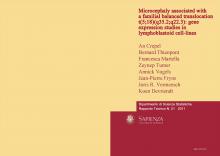Autore:
A. Crepel, B. Thienpont, F. Martella, Z. Tumer, A. Vogels, J. Fryns, J. R. Vermeesch, K. Devriendt
Abstract:
Background Autosomal dominant non‐syndromic microcephaly is a rare and heterogenous condition of unknown genetic etiology. However, chromosomal imbalances that have repeatedly been associated with microcephaly may offer a way to identify novel genes for non‐syndromic microcephaly. One such region is 5q35.2. Microdeletions in 5q35.2 including the gene NKX2.5 are associated to congenital heart defects and microcephaly. Since mutations in NKX2.5 are causal for congenital heart defects but are never associated with microcephaly, 5q35.2 deletions cause a contiguous gene deletion syndrome. Thus, in this chromosomal region a gene or regulatory element associated to dominant microcephaly is present. Methods We present a unique family where a balanced translocation t(5;18)(q35.2;q22.3) segregates with microcephaly in 4 out of 7 carriers. Fine mapping of the breakpoints was performed by use of 1 Mb BAC/PAC array Comparative Genome Hybridisation (array‐CGH), Fluorescent In Situ Hybridisation (FISH) and consecutive rounds of quantitative Real Time PCR (qRT‐PCR). Rigorous gene expression studies of all genes within a 4Mb region flanking the intergenic breakpoint on chromosome 5q35.2 were carried out on EBV‐transformed lymphoblastoid cell‐lines from 5 carriers by means of qRT‐PCR. Results Fine mapping of the breakpoints revealed that the breakpoint on chromosome 5q35.2 was located in an intergenic region previously associated with non‐syndromic microcephaly. Of the 27 genes in this region, only 11 revealed a reliably detectable expression pattern in these cells. However, in contrast to a positive control carrying a deletion in the region, for none of these genes, a significantly altered expression was observed. Conclusions The clinical and genetic findings support the observation that chromosome region 5q35.2 harbors a gene implicated in microcephaly, but also illustrate the limitations of the use of EBV‐transformed lymphoblastoid cell‐lines in expression studies of genes involved in brain growth.
Parole Chiave:
Gene expression data, k‐mean algorithm, t‐test
Tipo di pubblicazione:
Rapporto Tecnico
Codice Pubblicazione:
21
Contatto:
ISSN:
2279-798X


